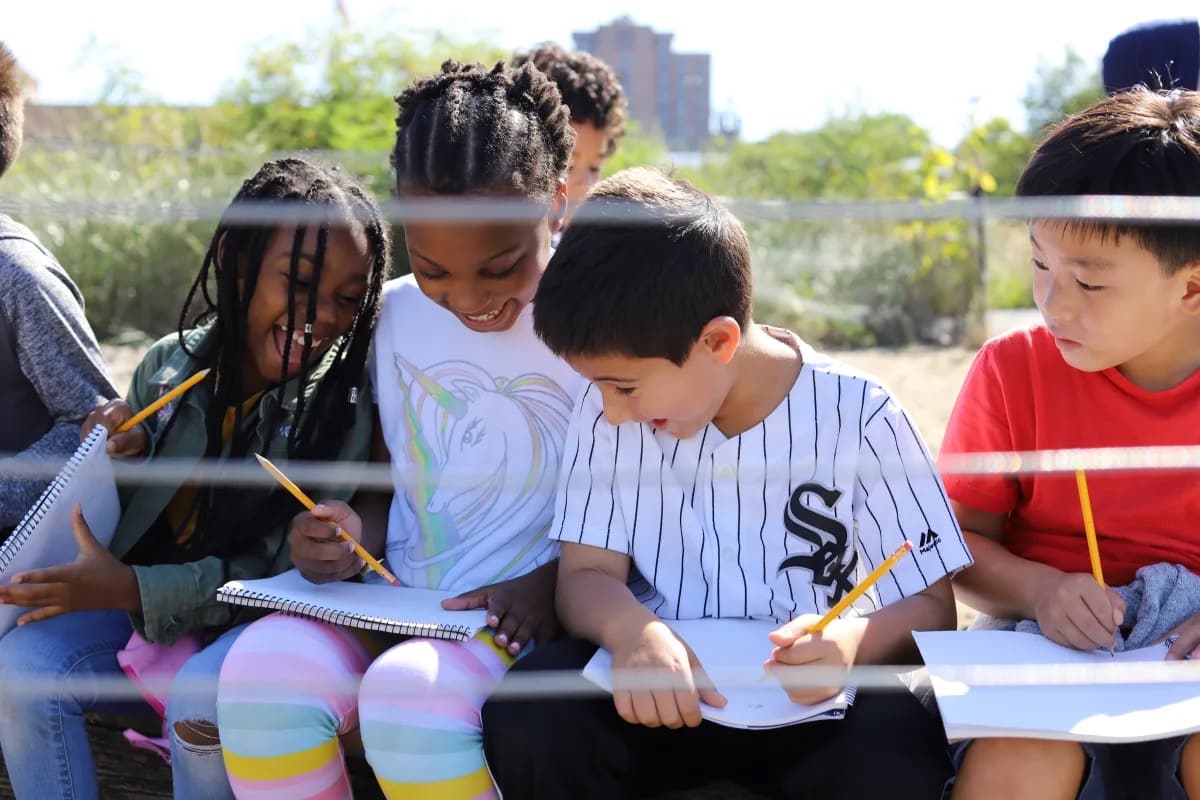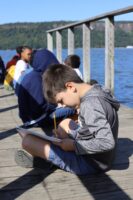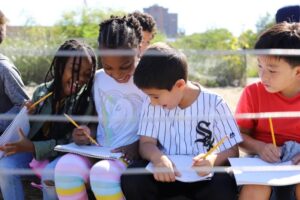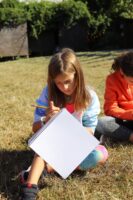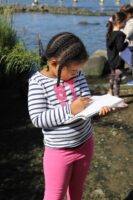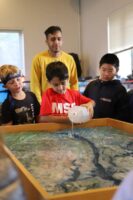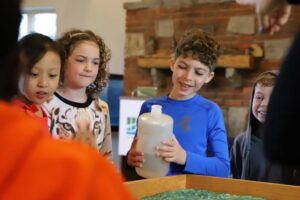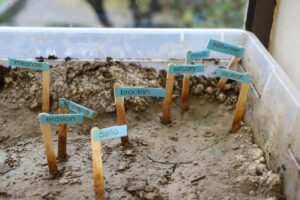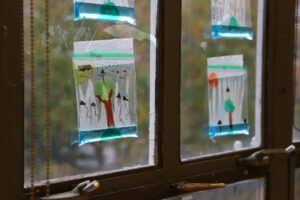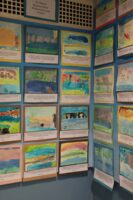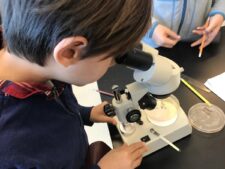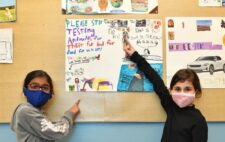Fall has barely set in at the Center for the Urban River at Beczak, an environmental education center in Yonkers, but students in Monique Astengo-Rosen’s 2nd Grade class are already bundled in sweaters and jackets, anticipating the cool breeze from the Hudson River. On the bus ride over, they are happy and hyper, chattering and asking each other if they’ve been to Yonkers or the surrounding towns in Westchester County. Sketchbooks in hand, they clamber off the bus and shift impatiently as they wait in line, eager to go out into nature. It’s looking to be a beautiful day.
From September to June, 2nd Graders at Fieldston Lower study bodies of water. It’s an ambitious, sprawling curricular piece: Students might craft haikus and multimedia collages dedicated to waterfalls around the world, or they may construct a life-sized model submarine in their study of deep-sea exploration. What’s particularly exciting is that students can experience many bodies of water firsthand, on class field trips to the rivers, ponds, and seaports that surround them in New York City.
Today’s assignment, to draw the natural environs at Beczak, is an introduction to the unit. Students spread out across the dock and the sandy riverbank and put pencil to paper. Anna K. ’30 depicts the river grass with energetic strokes. Dylan A. ’30 sketches the cliffs of the Palisades with a steady hand, but also adds in tugboats, imagining what they would look like if they were drifting along the river.
Already, our 2nd Graders are finding the river a fruitful source of inspiration — one that will continue to inspire throughout the year.
On an easel in her classroom, Sari Givner has shaded in a sinuous blue curve and labeled it with the parts of a river. At the top: the source. Next to it: thin tendrils marked as tributaries, which feed into the river as it moves past an area of erosion, past another freshwater source, and into the mouth, where it joins the ocean. Elsewhere on the chart: a waterfall, a delta, a meander — used here not as a verb but as a noun to signify the winding path of a flowing body of water.
It’s a lot of terminology for 2nd Graders to process, but they manage it with aplomb. (Ask anyone in 2nd Grade what an estuary is, and you’ll get an eager response.) Students read about rivers — their nomenclature, their flora and fauna, the science of their movement — and compile the information they’ve learned in hand-drawn flip books pinned to the wall. There’s a tactile, experiential component, too. Students recreate miniature riverbeds in plastic boxes, sticking labeled flags into the clay to match the various labels on Givner’s chart. They then drip water into the boxes, watching how it moves. On a sunny day, they go out into the playground to construct a large-scale version in the sandbox, filling it with water from a hose. This multisensory experience is a prime example of progressive learning: “It’s something we can literally smell, feel, and touch and observe firsthand,” says Givner.
A couple weeks later, it’s time for Givner’s class to visit Beczak, where students encounter the most elaborate river model yet. The class gathers around a rotating table on which a scale model of New York has been embedded. The table tilts as Elisa Caref, Director of Education at the Center for the Urban River at Beczak, cranks a wheel on the side, allowing the water placed on the table to flow in the direction of gravity.
Looking at this topographical map of their city, students point to geographical features they recognize. The Hudson River, just to the west of school. The Harlem River, just to the south. The East River; Governor’s Island; Randall’s Island; the Palisades, across the Hudson River from Beczak, where they are. Someone points at dotted lines and asks if they’re railroad tracks — they’re in fact state lines, but this opens the door to talking about man-made features as well: the George Washington Bridge, the Tappan Zee Bridge, the Lincoln Tunnel.
This geographic fluency is a testament to a broader initiative by Fieldston Lower faculty to foster in students an increased awareness of their surroundings. As students progress through the grades, they develop a mindfulness of how they interact with their world, starting with the classroom and expanding to the school, to the neighborhood, to the New York metropolitan area, and finally to society at large. It’s a pedagogical decision that’s ethical as well, in line with ECFS’ mission of educating informed citizens of the world.
At the water table, Caref spritzes dyed water from a spray bottle to demonstrate the fall of rain. Students take a minute to discuss how homes near the water — perhaps even theirs or their friends’ — are affected when heavy precipitation leads to flooding. A sprinkling of black pepper represents the dumping of waste and chemicals into the water supply, and students pause again to consider the ecological ramifications of pollution.
Finally, students have the chance to interact with the water table themselves. One by one, they take turns pouring water into the model river, watching how their actions affect the world around them.
Back at Fieldston Lower, Astengo-Rosen is holding a plastic cup with a dollop of shaving cream suspended on top. She drips blue dye into the foamy mass until it’s oversaturated and releases its contents — drip, drip — below. A raincloud in a cup — the students are delighted, and they rush to recreate the experiment themselves.
Experiments and arts and crafts projects like these offer insight into the science of water, another integral component of the 2nd Grade study of rivers. Outside the classroom, Astengo-Rosen’s students have glued together collages of pipe cleaners and sequins that represent the cycle of precipitation, collection, and evaporation. They’re fun hallway decorations with a scientific bent.
“Water is something [students] experience every day,” says Astengo-Rosen, “but they may not have given much thought to it — to rain or to how clouds form. It’s something that’s part of their everyday lives — it’s something they interact with regularly — so it has a real meaning to them.”
In the classroom, there’s another visualization of the hydrologic cycle. Taped to the windows of Astengo-Rosen’s classroom are plastic bags students have filled with water, dyed turquoise. When sunlight hits, it turns into vapor, condenses on the side of the bag, and slides back into the pool at the bottom, completing a cycle that the students have mapped out with arrows on the bags. Some students have even drawn trees, to illustrate how the transpiration of water from plants contributes to the movement of water through nature.
“The water cycle in a bag is a great example of hands-on learning that we try to incorporate as much as possible,” explains Astengo-Rosen. “All children are natural scientists with their eager curiosity and drive to explore the world; I just give them the platform to do what comes naturally to them.”
Winter momentarily puts a halt to the field trips to Beczak, but the 2nd Grade will return in the spring. When the weather has warmed, students will go seine fishing as they explore the creatures that live in the river. They’ll also venture to the South Street Seaport to go sailing and trawling, and to Van Cortlandt Park to fish with bamboo rods, exploring the many waterways of the city.
It’s science, it’s language arts, it’s learning new and different things.
As Givner explains, “[This unit] brings in all the pieces that [students] need to develop. It’s science, it’s language arts, it’s learning new and different things.” Outside her classroom is a collection of watercolors her students have painted of the Hudson River. Underneath each painting is a caption students wrote with the help of a thesaurus, expanding their vocabulary and their appreciation of poetry as they talk about “shimmering sunlight” or the Palisades that “guard” and “protect” the river.
Eitan S. ’30 writes, “The Hudson River is breathing life into nature.”
Breathing life into nature, and into our 2nd Grade classrooms as well.
